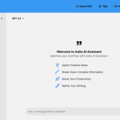Teacher Services
The Teacher services team advances learning centricity and the quality of teaching by offering support services for the teaching staff. The team is a part of Learning Services.
The principles of feedback guide all our work with student feedback. The aim of the principles is to support an interactive, impactful and streamlined feedback culture at Aalto. Student feedback is a valuable tool in which we want to invest. AI can be used as an aid in processing feedback, but it does not replace human processing of feedback. For example, AI can pick out topics, classify responses or look for connections, especially when handling a large amount of open responses. However, AI outputs must always be reviewed by a human.
Aalto AI Assistant is the university's AI tool that can be used as part of the analysis of student feedback. These guidelines provide instructions for the safe and responsible use of AI in feedback analysis. They aim to assist you in the processing procedure.
To ensure ethical conduct, please familiarise yourself beforehand with the guidelines on student feedback and generative AI, if you are not already aware of them. Responsible data use is one ofAalto’s ethical principles. You are responsible for following the rules on the storage, processing and sharing of any data you collect and analyse. Transparency is important: if you are planning to use AI as a part of your analysis processes, make preparations to inform your respondents about your use of AI: You can do this during lectures, in communications about the survey, or in the survey itself.
When planning to collect feedback, format the questions in a way that they do not lead respondents to disclose their identities or, for example, their health information. Do not ask anything unnecessary, that is, questions where the answers received will not be utilised. From the perspective of feedback impact, the purpose of collecting it must always be considered in advance.
Students should be instructed to respond in a way that provides no health information or information that could be used to identify them. You can inform them about this in lectures, any communication materials or in the survey itself. Make sure to inform respondents also about the purpose and methods of feedback analyses.
Sometimes the feedback forms include a reminder, for example, the course feedback form might read ‘Please do not include confidential or secret information, such as your own or others’ personal or health information.’ The guidelines on data classification provide more information on what kinds of data can be processed and stored in different systems and services. Ensure that your respondents are aware of how their answers will be used in the development of teaching and learning. Conducting research on student feedback must always go through the research permissions process before the research begins.
Examine the data you have received. Do the respondents seem to have understood the questions as intended? Has anyone included information in their responses that could identify an individual or individuals? When using AI tools for processing student feedback, the responsibility for data security is emphasised. Decide which parts of the data analysis you need AI assistance with, and separate those parts from all other data. It is particularly important to separate all data that could identify the respondent from the data to be analysed. Lists of respondents and names occurring in responses are concrete examples of this. Also, remember to consider indirect identifiers, which when combined could identify a respondent. For example, in very small courses, a combination of major, year of starting studies, and accumulated study credits, if asked in the feedback, may be enough to identify the respondent.
Using AI in the feedback processing procedure does not replace humans, but serves as an aid, and it is important to recognise its limitations. Small amounts of feedback often do not require AI assistance.
Once you have extracted the appropriate data from your original dataset for processing by AI, you can transfer it to Aalto AI Assistant. When using generative AI to analyse student feedback, always use Aalto AI Assistant, as it is the only AI tool permitted for handling student feedback at Aalto University. The use of Aalto AI Assistant ensures that neither the data nor the prompts are used to train the AI model. You can use Aalto AI Assistant, for example, to theme responses, summarise them, or outline how topics that interest you appear in the responses. Always critically evaluate the AI results before using them as part of your development work. Once your analysis is complete, always remember to delete the data and discussions you used from Aalto AI Assistant. You can find detailed instructions on this in the Aalto AI Assistant guidelines.
AI can be more beneficial when you want to search for and process feedback on a specific recurring issue. It might not be able to identify all necessary aspects when it comes to recognising less frequent accessibility problems or student concerns.
It might also be useful to try out the Aalto AI Assistant's prompt book. It is worth experimenting with different prompts to find those that best suit your needs.
Remember that using AI to handle feedback does not yet mean that the feedback has been processed. The outputs of AI can help in reflecting on the feedback, but they must be reviewed, and further development actions need to be decided and implemented by a human. Peer discussions about feedback and developmental actions have proven to be very useful. It is important that the impact of feedback on teaching and education is also visible to the students. We therefore encourage you to share the results of your feedback analysis openly with your students, colleagues and other stakeholders. When sharing your findings and results, ensure that your audience has the right to see the level of information you intend to share.
Read also: The new PowerBI report views for course feedback now published | Aalto University
Your personal AI assistant

The Aalto University Code of Conduct is one way of putting our values and way of working — the foundation of our community culture — into practice

In Aalto, feedback is collected from students during different phases of their studies. Hearing the voice of students is vital for the development of teaching and training as well as for quality assurance and for improving study-related services. Feedback is used on multiple levels in many ways and its utilisation is a special area of focus in Aalto. Student guilds and organisations are also interested in and benefit from feedback and surveys.

Guidance for the use of artificial intelligence in teaching and learning at Aalto University.

Using generative AI every day is going to transform how you do your work in the next few months and years. This page gathers some current tips for your reference.

The EU General Data Protection Regulation (GDPR) is applied as of 25 May 2018 in all of the EU member states.
Tips how to use AI in teaching


The Teacher services team advances learning centricity and the quality of teaching by offering support services for the teaching staff. The team is a part of Learning Services.

This page describes what learning analytics solutions Aalto University offers and how to get support for using them.